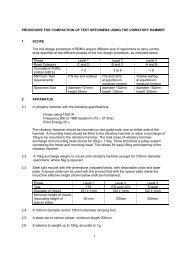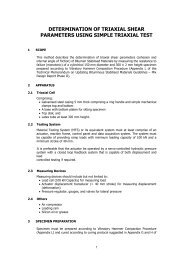Updating Bituminous Stabilized Materials Guidelines Mix Design Report Phase II
Moisture Sensitivity: Part II (Validation) - Asphalt Academy
Moisture Sensitivity: Part II (Validation) - Asphalt Academy
- No tags were found...
You also want an ePaper? Increase the reach of your titles
YUMPU automatically turns print PDFs into web optimized ePapers that Google loves.
Figure J.4: The measuring wheel of the Profilometer roll on surface of briquette<br />
The profilometer is placed on the index bars when measuring the surface of the briquettes. The<br />
index bar is there as a reference for future readings on the same briquette, see Figure 3.<br />
The first profile measurement taken on each briquette before any load application, this is the<br />
zero reading before any deformation. After each loading interval, the height of the briquettes is<br />
measured. The deformation readings are stored electronically. The readings of all the intervals<br />
of one definite briquette plotted on a single graph and then illustrate the deformation to load<br />
repetitions.<br />
The rut depth of a number of loads repetitions is defined as the maximum vertical downwards<br />
deformation in the wheel track. The upward deformation next to the wheel track defined as the<br />
heaving. It occurs when material from the path of the wheel pushing outwards to the side of the<br />
wheel, either through creep or through classical shear. This phenomenon however, is typical for<br />
the HMA, and not for BSMs.<br />
A typical example of HMA surface profile after trafficking presented in Figure J.5 below.<br />
Figure J.5: Typical plot of the HMA surface of deformed profile<br />
5












